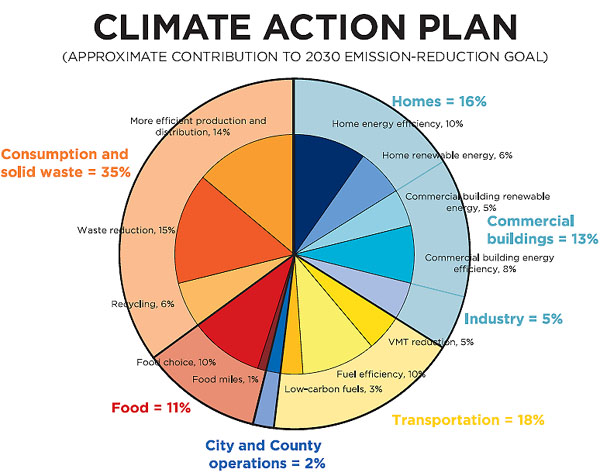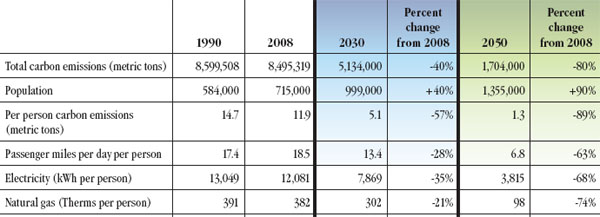File Under Portland Envy

This past October the Portland City Council adopted a new Climate Action Plan, coauthored by the City and Multnomah County. The Plan includes a greenhouse gas (GHG) inventory, similar to the report recently published by the City of Seattle, but that’s where the similarity ends. Because apparently unlike Seattle, Portland is taking the issue of climate change seriously enough to follow up their GHG inventory with in-depth analysis, goals, and proposed actions.
The Portland/Multnomah County GHG inventory results look a lot like Seattle’s, with two notable exceptions. First, Multnomah’s total emissions have not fallen as much as Seattle’s—in 2008, Multnomah County’s emissions were one percent below 1990 levels, as compared to the seven percent drop achieved in Seattle. Seattle fared better because of larger reductions in emissions from the industrial and building sectors.
Second, Multnomah’s inventory doesn’t include air travel, so with that subtracted from Seattle’s data, Seattle wins the per capita emissions contest—9.2 metric tons per person per year compared to 11.9 metric tons in Multnomah. But, as has been discussed previously, the low carbon intensity of Seattle’s electricity complicates interpretation of these data points. In 2008, per capita electricity consumption was nearly the same—13,355 kWh in Seattle, and 12,074 kWh in Multnomah—but the per capita GHG emissions associated with that electricity use were 21 times higher in Multnomah than in Seattle.
It’s debatable how to account for regional elements like the electricity grid in local GHG inventories. But if Seattle gets credit in the GHG reduction contest for taking the initiative to build hydropower dams, then they also have a corresponding responsibility for the decimation of the salmon runs, which impacts the entire Pacific Northwest.
Another artifact of the higher carbon intensity electricity in the Portland area is a reduction of the relative contribution of transportation to total GHG emissions—it’s 38 percent in Multnomah, compared to 62 percent in Seattle. But that doesn’t mean people are driving less in Seattle. Depending on who’s numbers you believe (e.g. here, here, here, or here), per capita vehicle miles traveled in both places are in the range of 20 miles per day.
The short story is that carbon footprints are similar in Seattle and Portland because people’s lifestyles are essentially the same in both cities. But one marked difference between the two cities is how they followed through on all that GHG data they collected. Seattle’s analysis was minimal, as noted in previous posts (here, here, and here). In contrast, Portland uses the GHG inventory as a foundation upon which to build and extensive set of goals and actions for addressing climate change.
Reduction targets are established for 2030 and 2050. Goals and actions are divided into broad range of categories: Buildings and Energy; Urban Form and Mobility; Consumption and Solid Waste; Urban Forestry and Natural Systems; Food and Agriculture; Community Engagement; Climate Change Preparation; and Local Government Operations. And it’s all packaged up in a 70 page document with great graphics and thoughtful writing. The table below provides a good summary.

>>>
Portland envy among urbanists has become a cliche, and there may well be more hype than substance. But still, there is something palpably exceptional about Portland’s approach to promoting sustainable urbanism, and in particular they always seem to be a few steps ahead of Seattle. For example, here’s a list of Portland area organizations that contributed to the Climate Action Plan:
- City of Portland Peak Oil Task Force
- Portland and Multnomah County Sustainable Developoment Commission
- Portland and Multnomah County Food Policy Council
- Mayor’s Planning and Sustainability Cabinet
Did you catch that? Portland has an official Peak Oil Task Force. Here in Seattle I get the sense that most of our electeds are uncomfortable even uttering those words. And that last item in the list sure has a familiar ring to it.
It’s a curious thing, this cultural contrast between Portland and Seattle. Demographically, the populations are almost indistinguishable. At the risk of overly generalizing, perhaps the most pertinent difference between the two cities is that Seattle is more “corporate.” Is it as simple as that?
